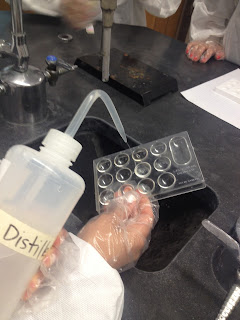Nina G.
Nicolette E.
Dr. Forman
Chemistry
Abstract: The purpose of this lab was to identify unknown elements and reach a conclusion if the elements was a metal, nonmetal, or metalloid. Through our observations of the elements color, luster, form, type of metal, durability, conductivity, and reactiveness we reached our results. Overall we discovered that A, B, C, and F were metals, E was a nonmetal, and D and G were metalloids.
Procedure:
1. Cleaned out our well plate to make sure there was no leftover substances in the plate wells from a previous group
2. Got element A from the cart
3. Recorded it's appearance (Color, Luster, and Form)
4. Checked its conductivity using the electical conductivity apparatus by cliping both clamps of the conductor on both sides of the element seeing if the light turned on, which meant it was conductive or if it didn't light up, which meant that it was not conductive
5. Then we checked it durability using the a metal ring as the hammer
6. Wrote if it was conductive and if it was brittle or malleable
7. Then we labeled the plate wells A through G
8. Placed element A in the one of the wells
9. Poured 18 drops of 0.1 CuCl into the well with the element A
10. Then we waited 3 minutes to see if there was a change
11. Wrote the result for element A's change
12. Repeated these all these steps for elements: B, C, D, E, F and G and wrote the results for each
13. We got a new plate well and got another of elements: A, B, C, D, F, and G but there was none of element E left so we got the results from the group across from us
13. Then we poured 18 drops of 0.5 HCl into each well
14. Waited 3 minutes
15. Recorded if there was a chemical change or if there was not
16. Put our equipment onto the cart.
17. Washed our hands
Chemical Reactions for 0.1 CuCl:
Chemical Reactions for 0.5 HCl:
Lithium Data:
Histogram:
There was aggregated data because some groups may have not known how to determine whether it was a metal, metalloid, or nonmetal with there results. For example some may have noticed that the element was not shiny and may have automatically assumed it was a non-metal, without looking at the rest of their results. In the data the main elements that varied the most were element D since there was only one nonmetal, element E where there was only one metal, and element G where there was only one metal.
Significance of the Lab:
This lab was significant because it really made each group work as a team and communicate with eachother. Also this lab really made each group look at the details of each element as well as making us use our knowledge of metals, nonmetals, and metalloids to figure out our results.
Questions, pg.177 #1-4
Questions, pg.177 #1-4
1.
Color-physical
Luster- physical
form- physical
conductivity- physical
reactivity- chemical
Hammer- physical
2.
Group 1 (physical): D,E,F
Group 2 (chemical): A,B,C,G
3. Elements D, E, and F fit into the physical group of elements because they are non-reactive and have a distinctive appearance. Elements A, B, C, and F fir into the chemical group of elements because they are reactive.
4.
Metals: A, B, C, F
Nonmetals: E
Metalloids: D, G













No comments:
Post a Comment